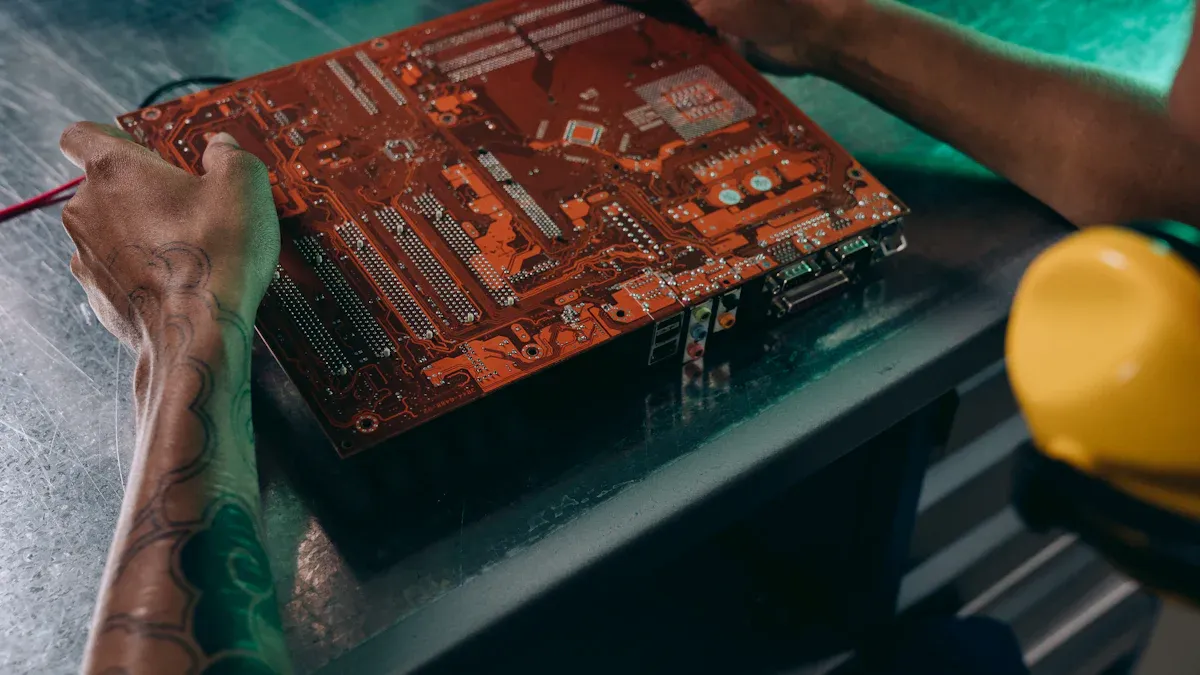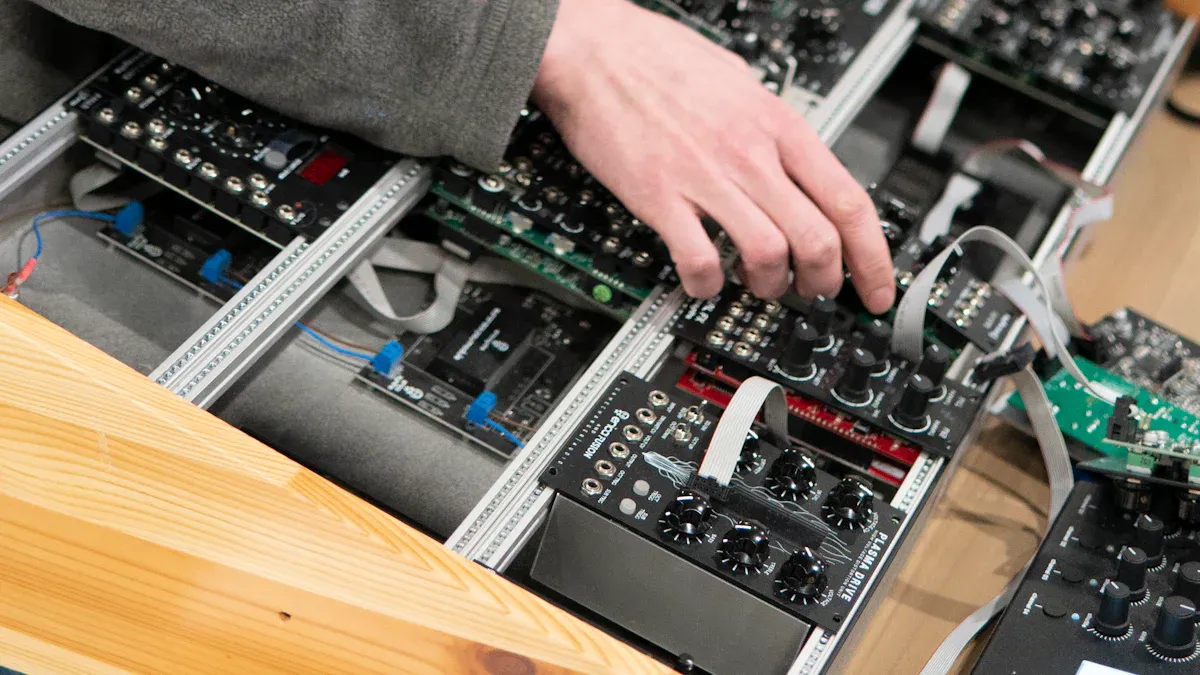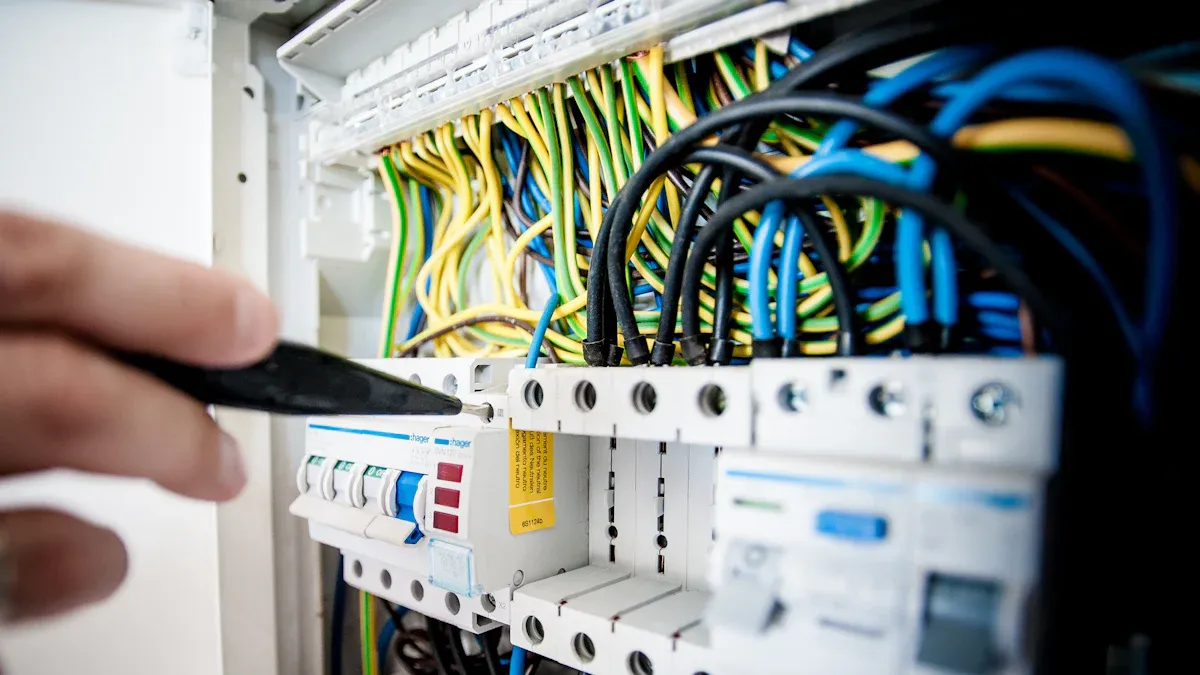
Industrial safety relies heavily on a well-made and assembled industrial safety system PCB assembly. These components operate systems that ensure worker safety and prevent accidents. Many people are unaware that electrical hazards account for 52% of worker fatalities in industries such as construction. Over the past decade, more than 20,000 U.S. workers have been injured in electrical incidents. The integration of PCB assembly in safety systems plays a crucial role in reducing these risks. It enables safety functions, such as effectively preventing arc flashes, which can reach temperatures exceeding 35,000°F.
Key Takeaways
PCB assembly is important for safety systems to work properly.
It helps protect workers from dangers in the workplace.
Following strict rules like IPC and ISO makes PCBs safe and reliable.
Testing PCBs with tools like Automated Optical Inspection checks their quality.
Using strong materials and robots makes PCBs last longer and work better.
Smart PCBs with IoT technology make safety systems smarter and faster.
They give real-time data and quick alerts for possible dangers.
Industrial Safety System PCB Assembly: Definition and Role
What is PCB assembly?
PCB assembly means putting electronic parts onto a printed circuit board (PCB) to make it work. This process has steps like soldering, checking, and testing. Think of it as the heart of modern devices, where every part is placed carefully to make sure it works right.
Manufacturers follow strict rules to keep quality high. For example, IPC rules like IPC-A-610 and J-STD-001 explain how to solder and check parts. These rules make sure every PCB assembly is safe and works well.
Standard Code | What It Covers |
|---|---|
IPC-A-610 | Checking if electronic parts are acceptable |
IPC-A-600 | Checking if printed boards are acceptable |
J-STD-001 | Rules for soldering electronic parts |
IPC-7711/IPC-7721 | Fixing and repairing electronic parts and boards |
By following these rules, manufacturers make strong PCBs for safety systems.
How PCBs enable safety-critical operations
PCBs are key in safety systems because they control safety tools. They read signals, watch for problems, and act to stop accidents. For example, a PCB in a safety system might notice a machine getting too hot and turn it off before it’s dangerous.
PCBs are made to be precise and dependable. They often have backup systems so they still work if one part breaks. IPC rules help make PCBs even more reliable by giving clear steps for making and testing them. These rules help avoid problems and meet safety laws.
Examples of industrial safety systems relying on PCBs
Many safety systems need PCBs to work well. Here are some examples:
Fire suppression systems: PCBs run sensors and tools to find fires and spray extinguishers.
Emergency stop systems: PCBs stop machines quickly during emergencies to keep workers safe.
Gas detection systems: PCBs read sensor data to find harmful gases and start alarms or fans.
Machine guarding systems: PCBs control locks and barriers to keep people away from dangerous machines.
These systems depend on well-made PCBs to do their jobs. Without good PCBs, these safety tools wouldn’t work as well.
Challenges and Requirements in PCB Assembly for Safety Systems
Making PCBs reliable in tough conditions
Factories can be hard on PCBs with heat, shaking, and chemicals. To make them last, strong materials and special tests are needed. For example, thermal shock tests check if PCBs handle quick temperature changes. Vibration tests see if they stay strong when shaken.
Some common tests include:
Automated Optical Inspection (AOI): Finds mistakes during assembly.
Electrical Testing: Checks for problems in the circuit.
HALT/HASS Tests: Push PCBs to their limits to find weak spots.
These tests make sure PCBs work well in safety systems, even in tough places.
Building PCBs with no mistakes for safety
In safety jobs, even small PCB mistakes can cause big problems. Every step must be done carefully. Machines like pick-and-place robots and soldering tools help avoid human mistakes and make things more accurate.
Extra checks, like electrical stress tests and electromagnetic compatibility (EMC) tests, make sure PCBs work right. These steps help make perfect PCBs for safety systems.
Adding backups for safer designs
Backups and fail-safe plans are key for safety systems. They keep things working if a part breaks. For example, car brakes use extra sensors to stay safe. Spacecraft use Triple Modular Redundancy (TMR) to stay reliable in space.
Adding backups means having spare parts or systems. For example:
IoT devices: Use timers or extra hardware for important tasks.
Aircraft systems: Have fail-safe designs to keep working if parts fail.
With backups and fail-safe plans, safety systems become more reliable and secure.
Technologies and Advancements in PCB Assembly for Safety Systems

New materials for stronger and better PCBs
New materials are making PCBs work better in safety systems. Materials like nanomaterials and flexible bases help with heat and bending. These are important for things like IoT devices and electric cars. For example, CF-004 is a new material that handles heat well and doesn’t break easily. It also protects solder joints, making PCBs last longer in hot places.
These materials also improve how electricity flows. CF-004 reduces signal loss in high-frequency circuits. This helps keep signals clear in safety systems. By using these materials, companies can make PCBs that work well in tough conditions.
Using robots and machines to build PCBs
Robots have changed how PCBs are made, especially for safety systems. Machines apply materials perfectly, wasting less and saving time. For example, Automated Optical Inspection (AOI) finds mistakes like misplaced parts or bad soldering. This ensures only good PCBs are used.
Robots also help avoid errors. Smart systems spot problems early, making production faster and more reliable. Using robots helps make high-quality PCBs that meet strict safety rules.
Smaller and smarter PCB designs
Modern safety systems need small but powerful PCBs. New tech like high-density interconnect (HDI) makes smaller designs possible. These tiny PCBs save space but still work well, which is important in tight spaces.
Flexible and rigid-flex PCBs are also helpful. They allow more parts to fit while staying strong and handling heat. 8-layer PCBs reduce interference and keep signals clear. Copper layers in these designs remove extra heat, protecting parts. These improvements help PCBs meet the high demands of safety systems.
Compliance with Safety Standards in PCB Assembly
Overview of key safety standards for industrial PCBs
Making industrial safety system PCB assembly safe means following strict rules. These rules are made by global groups to keep electronics safe and reliable. Some key rules include:
International Electrotechnical Commission (IEC): Sets safety rules for electronic products.
Institute of Electrical and Electronics Engineers (IEEE): Gives tips for safe electronic designs.
OSHA Standards: Focuses on keeping U.S. workplaces safe.
General Product Safety Regulation (GPSR): Ensures safe products in Europe.
REACH Regulation: Limits harmful chemicals to protect people and nature.
These rules help companies make safe and trustworthy PCBs for industries.
Importance of certification and rigorous testing
Testing and certifications are very important for reliable PCBs. Testing finds problems before products are used in real life. Certifications like ISO 9001 and UL 796 prove that companies follow strict safety rules.
Tests like electrical stress checks and tracking parts help find issues fast. This is very useful in fields like healthcare, where devices must work perfectly. By focusing on testing and certifications, companies make safer systems.
How compliance enhances reliability and reduces risks
Following safety rules makes industrial safety system PCB assembly more reliable. It ensures products are tested and certified to avoid failures. For example, tests check if PCBs can handle tough conditions and still work well.
When companies follow these rules, they lower risks and gain customer trust. Reliable PCBs stop accidents and save lives, making safety rules essential. By meeting these rules, manufacturers create safer workplaces and better products.
Future Trends in Industrial Safety System PCB Assembly

AI and machine learning in PCB design and assembly
AI and ML are changing how PCBs are made. These tools study lots of data to improve every step. For example, AI can pick the best board size and part layout. ML can guess costs and find ways to save materials.
Here’s how AI and ML help the industry:
Application Area | Benefits |
|---|---|
Production Optimization | Planning better, saving materials, and speeding up work |
Quality Control | Cutting waste, improving quality, and making processes faster |
Manufacturing Efficiency | Lowering costs, keeping quality steady, and boosting output |
Design for Manufacturing (DFM) Tools | Checking if designs can be made, saving money, and predicting success |
AI Algorithms | Choosing board size, layers, and part placement |
Machine Learning Insights | Guessing costs, improving steps, and making work smoother |
Energy Efficiency | Using less energy, cutting waste, and picking eco-friendly parts |
Using AI and ML makes PCBs better and cheaper. These tools are very useful for safety systems where accuracy matters most.
Eco-friendly and sustainable PCB manufacturing practices
Making PCBs eco-friendly is now a big focus. New materials and methods are helping the planet. For example, recycling and low-heat processes are becoming popular. Experts say 20% of PCBs might be made sustainably in 10 years.
Here’s how the industry is going green:
Using lead-free materials and following RoHS rules to stay safe.
Recycling metals like copper and aluminum to cut waste.
Adding eco-friendly coatings to reduce harmful chemicals.
Following green rules like ISO 14001 to show care for nature.
The market for green electronics is growing fast. It could reach $150 billion by 2030, growing 25% each year. These changes help both the planet and businesses.
Smart PCBs and IoT integration in safety systems
Smart PCBs are making safety systems better with IoT tech. These PCBs can talk to devices, collect data, and act fast. For example, a smart PCB in a gas detector can send alerts or turn on fans.
IoT PCBs also help with repairs and tracking problems early. Flexible PCBs are great for IoT because they save space and stay strong.
Adding smart PCBs to safety systems makes them work better and faster. This keeps workers and machines safe all the time.
Industrial safety system PCB assembly helps keep workers and machines safe. It makes sure safety tools work well, even in tough places. New materials, robots, and smart designs make these systems stronger and better. Following rules like UL Certification, ISO 9001, and RoHS makes them safer and more reliable.
Standard | Why It Matters |
|---|---|
UL Certification | Proves electronics are safe for industries like cars and healthcare. |
ISO 9001 | Shows a focus on quality and happy customers. |
RoHS | Bans harmful materials in electronics, important for EU rules. |
Focus on new ideas and follow safety rules carefully. This helps make workplaces safer, products better, and customers trust you more. Using these improvements will keep industrial safety systems secure in the future.
FAQ
Why is PCB assembly important for safety systems?
PCB assembly helps safety systems work properly. It links and powers parts that find dangers, control machines, and stop accidents. Without good assembly, safety systems might fail, risking workers and tools.
How do PCBs handle tough conditions?
Strong materials and tough tests make PCBs last. Tests like heat and shake checks prove they can handle hard conditions. These steps keep PCBs working in rough factory settings.
Why follow safety rules for PCBs?
Safety rules make sure PCBs are safe and high-quality. Standards like ISO 9001 and UL Certification test and approve products. Following these rules lowers risks and earns user trust.
Can robots make PCB assembly better?
Yes, robots make PCB assembly more accurate. Machines and AI tools help with tasks like soldering and checking. This makes production faster, safer, and better for safety systems.
What are smart PCBs, and how do they help?
Smart PCBs use IoT to watch for problems and act fast. They gather data, send warnings, and trigger safety actions quickly. This makes safety systems smarter and better at protecting people and machines.
See Also
Exploring The Manufacturing And Assembly Of PCBA
Emerging Trends In PCB And PCBA Design
Essential Strategies To Enhance PCB Assembly Productivity